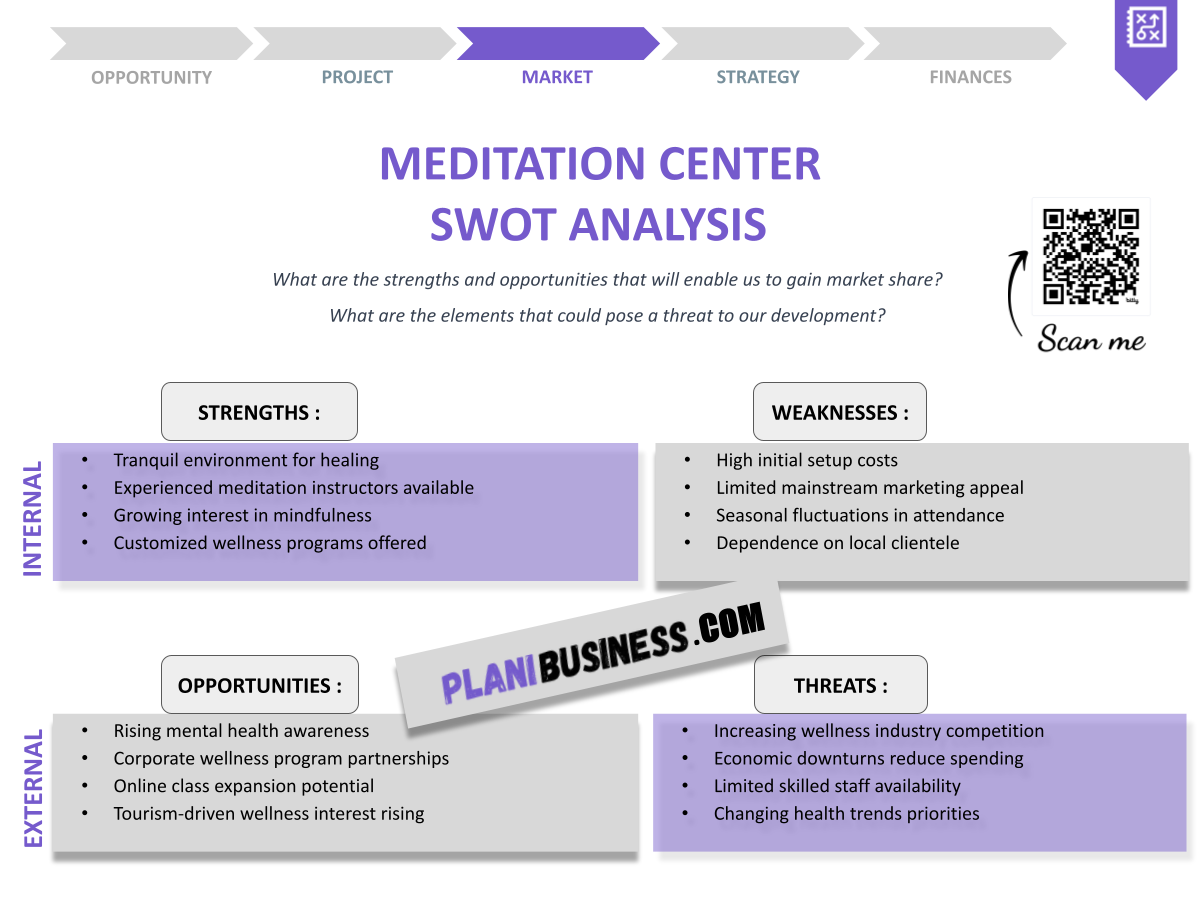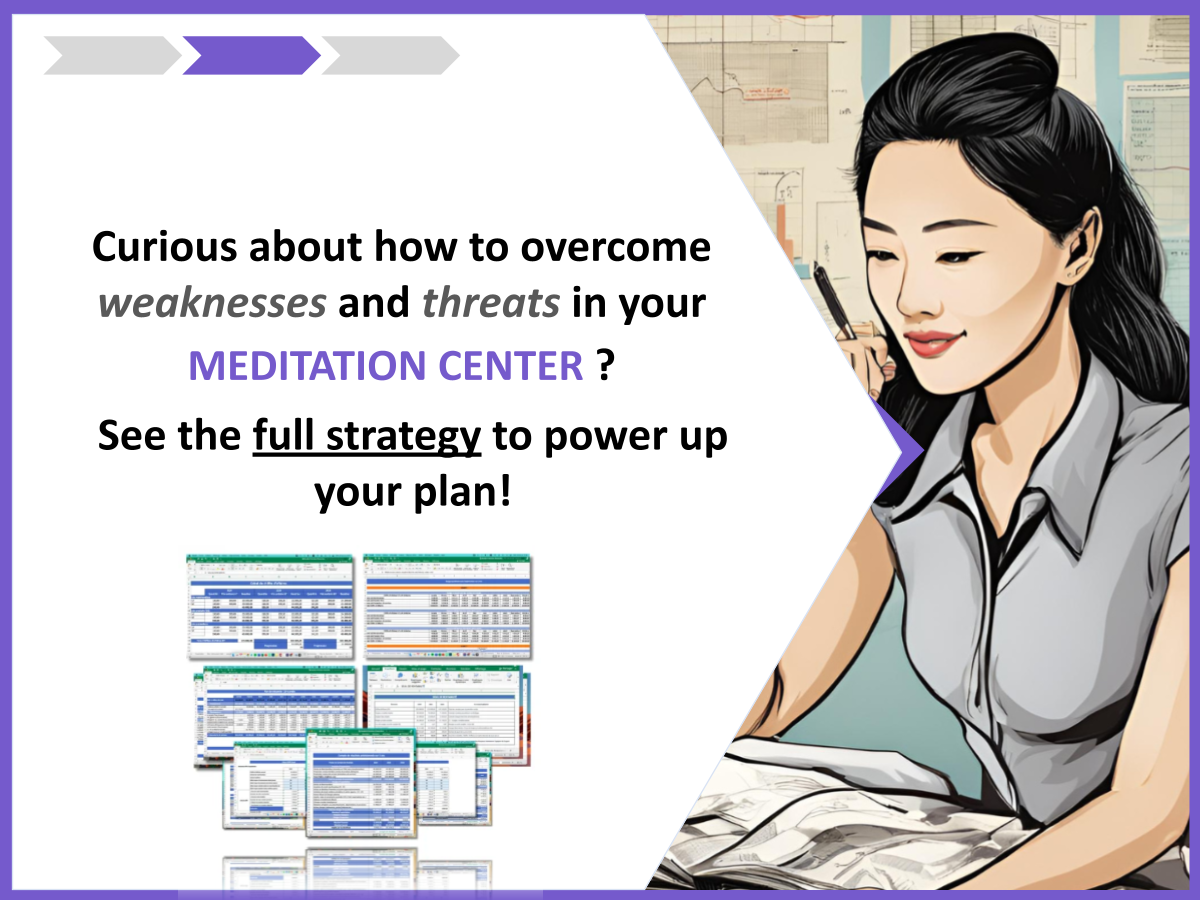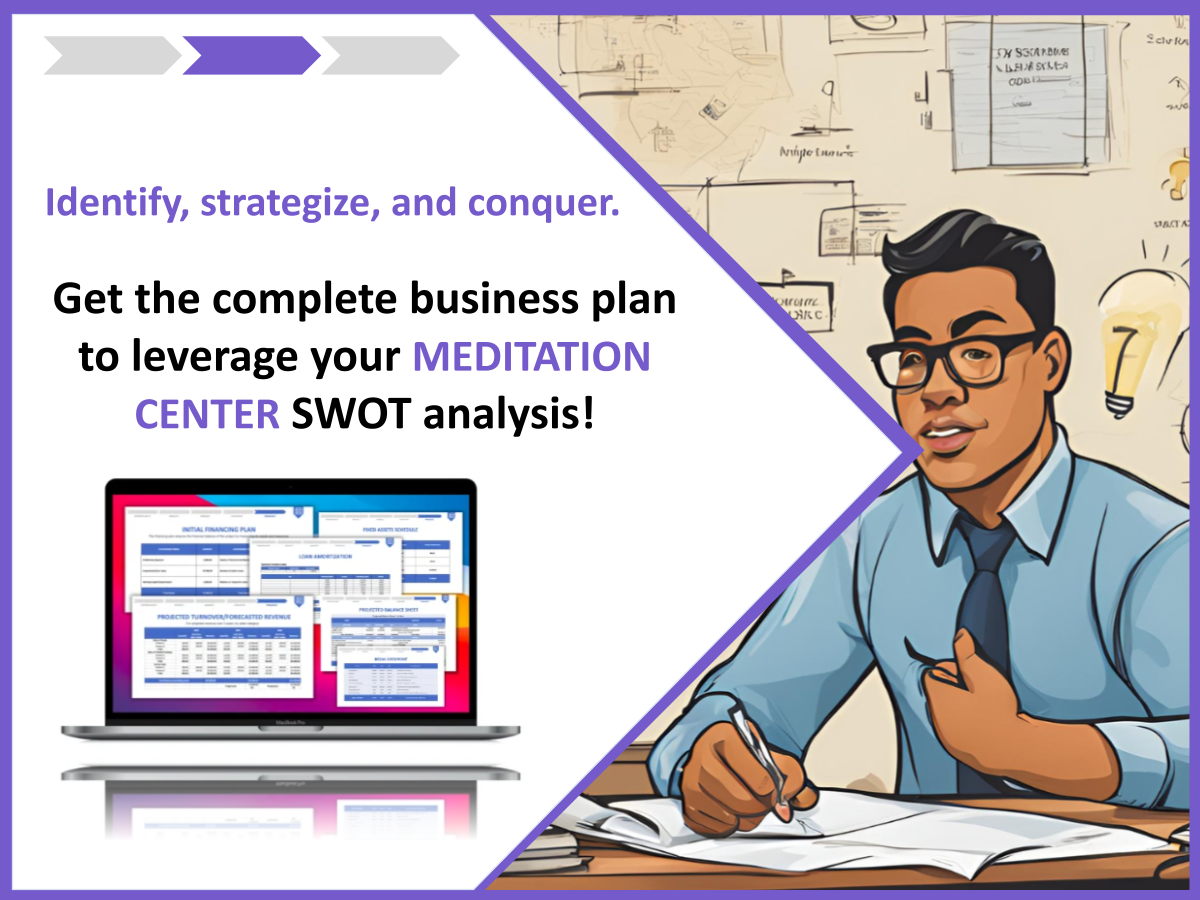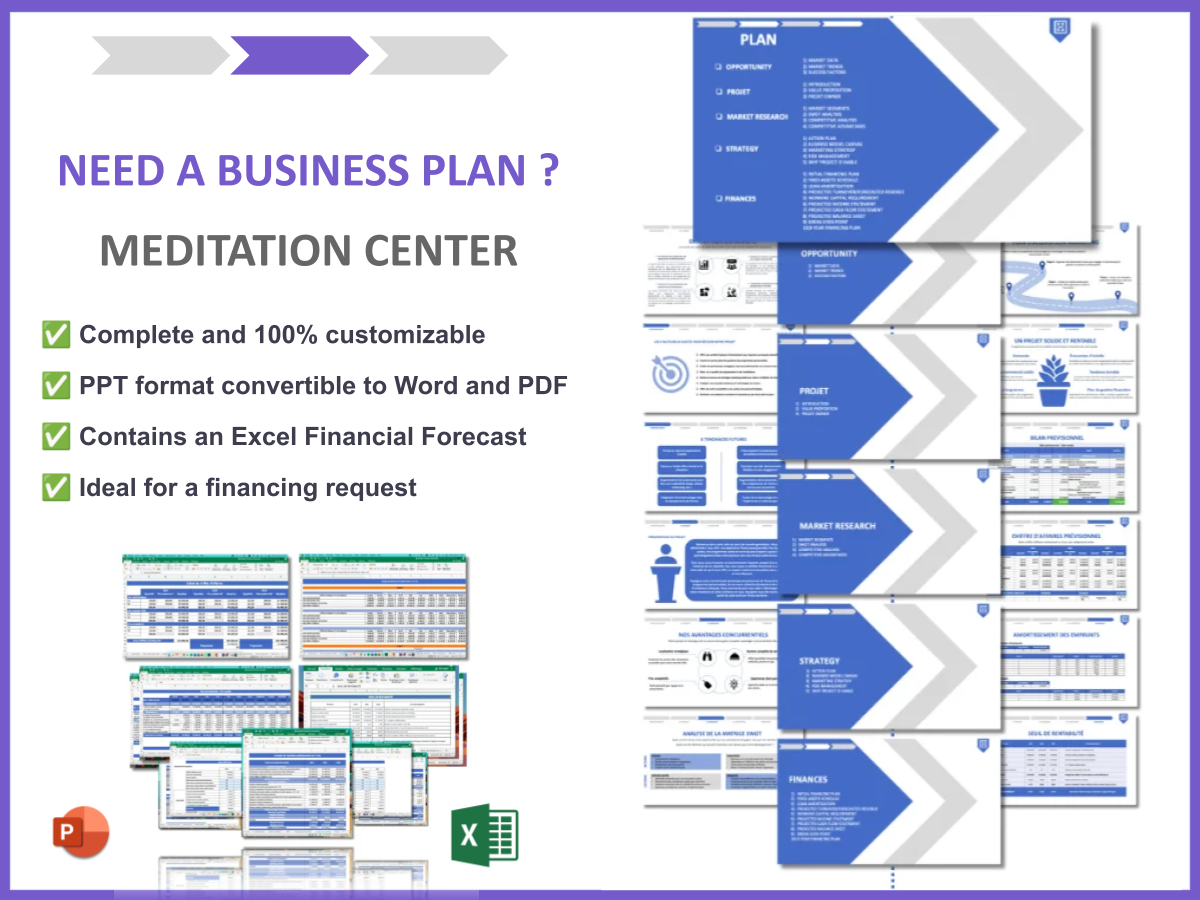Why Should You Have a SWOT Analysis for Your Meditation Center?
Are you considering opening a meditation center? You’re not alone! With a growing number of people seeking tranquility and mindfulness, the demand for meditation centers is at an all-time high. However, to stand out in this competitive market, a SWOT analysis is essential. A SWOT analysis identifies the Strengths, Weaknesses, Opportunities, and Threats that your center may face, providing a roadmap for strategic planning and growth.
Did you know that over 80% of new businesses fail within the first 18 months? This statistic highlights the importance of thorough planning and analysis in the wellness industry. By conducting a SWOT analysis, you can avoid common pitfalls and ensure your meditation center is set up for success.
A SWOT analysis is a strategic planning tool that helps organizations assess their internal and external environments. It provides insights that can lead to improved decision-making, effective marketing strategies, and sustainable growth.
- Understand your center’s unique strengths.
- Identify weaknesses to improve upon.
- Explore opportunities for growth and outreach.
- Recognize potential threats in the market.
- Create a strategic plan based on insights.
- Enhance decision-making processes.
- Foster a culture of continuous improvement.
- Attract investors or partners with clear analysis.
- Improve marketing strategies with targeted insights.
- Build resilience against market changes.
How Do You Write a SWOT Analysis for a Meditation Center?
Writing a SWOT analysis is a straightforward process that involves evaluating your meditation center’s internal and external factors. Start by gathering a team of key stakeholders and brainstorming each category. Here’s how to break it down:
Strengths
To identify your meditation center’s strengths, consider what sets you apart from the competition. These might include:
- Unique meditation techniques or offerings.
- Experienced instructors or facilitators.
- Strong community presence and support.
- Positive testimonials and word-of-mouth.
Weaknesses
Next, evaluate your weaknesses. This section is crucial for identifying areas for improvement, such as:
- Limited marketing budget.
- Lack of brand recognition.
- High operational costs.
- Dependence on seasonal attendance.
Opportunities
Look for external opportunities that can help your meditation center grow. Consider factors like:
- Growing trend in wellness and mindfulness.
- Potential partnerships with local businesses.
- Expansion of online classes.
- Increasing interest in corporate wellness programs.
Threats
Finally, identify the threats that could impact your meditation center. This could include:
- Competition from other wellness centers.
- Economic downturns affecting discretionary spending.
- Changes in consumer preferences.
- Regulatory changes impacting operations.
SWOT Example N°1 for a Yoga & Meditation Retreat
This example explores a yoga and meditation retreat center that offers immersive experiences designed to help individuals disconnect from daily stressors and reconnect with themselves.
| SWOT | Analysis |
|---|---|
| Strengths | Experienced instructors, beautiful location, tailored programs |
| Weaknesses | High pricing, limited accessibility, seasonal attendance fluctuations |
| Opportunities | Increase in wellness tourism, partnerships with hotels, online class offerings |
| Threats | Local competition, economic fluctuations impacting travel |
- Strong community ties that enhance customer loyalty.
- Diverse class offerings catering to various skill levels.
- Seasonal promotions to attract new clients.
- Environmental sustainability focus that appeals to eco-conscious guests.
The retreat center's focus on sustainability is a major draw for eco-conscious clients. While the pricing may deter some, creating tiered packages could broaden their appeal. Additionally, enhancing online marketing efforts can help reach a wider audience interested in wellness tourism.
SWOT Example N°2 for an Urban Meditation Studio
This example covers an urban meditation studio that caters to busy professionals seeking a quick escape from their hectic lives.
| SWOT | Analysis |
|---|---|
| Strengths | Central location, flexible hours, diverse class offerings |
| Weaknesses | High rent costs, limited space, dependence on walk-in clients |
| Opportunities | Corporate wellness programs, online meditation sessions, workshops |
| Threats | New competitors entering the market, changes in consumer preferences |
- Diverse class schedules that accommodate various lifestyles.
- Strong online presence to engage potential clients.
- Community events to foster connections and loyalty.
- Collaboration with local businesses to enhance visibility.
The urban studio has a great opportunity to leverage its location for corporate partnerships. This could significantly boost attendance during weekday sessions, particularly if they create tailored programs for local businesses focused on stress reduction and employee wellness.
SWOT Example N°3 for a Community Meditation Center
This example highlights a community meditation center that focuses on making mindfulness accessible to all, regardless of socioeconomic status.
| SWOT | Analysis |
|---|---|
| Strengths | Affordability, inclusive environment, strong community ties |
| Weaknesses | Limited funding, reliance on volunteers, lack of marketing expertise |
| Opportunities | Grants for wellness programs, collaborations with local nonprofits, expanding outreach |
| Threats | Funding cuts, competition from commercial studios, changes in community interest |
- Strong support from local community organizations.
- Free classes that attract diverse participants.
- Volunteer programs that foster community involvement.
- Workshops that educate on mindfulness and meditation.
The community meditation center's commitment to affordability is a major strength, allowing access to those who might not otherwise engage in wellness practices. However, to ensure sustainability, securing grants and developing marketing strategies to raise awareness are crucial next steps.
SWOT Example N°4 for a Corporate Meditation Program
This example examines a corporate meditation program designed to improve employee wellness and productivity within organizations.
| SWOT | Analysis |
|---|---|
| Strengths | Tailored programs for corporate clients, expert instructors, proven benefits for employees |
| Weaknesses | High initial costs for companies, limited awareness of meditation benefits, need for ongoing engagement |
| Opportunities | Increasing focus on employee wellness, potential for long-term contracts, expanding into new industries |
| Threats | Competition from other wellness programs, fluctuating corporate budgets, changing workplace priorities |
- High demand for wellness initiatives in the workplace.
- Positive feedback and testimonials from participating employees.
- Partnerships with HR departments to promote programs.
- Workshops that can be customized for specific corporate needs.
The corporate meditation program has a unique opportunity to capitalize on the increasing focus on employee wellness. By demonstrating clear benefits and providing flexible pricing options, the program can attract more businesses looking to enhance their work environment.
SWOT Example N°5 for an Online Meditation Platform
This example focuses on an online meditation platform that offers a variety of guided meditations and mindfulness resources accessible from anywhere in the world.
| SWOT | Analysis |
|---|---|
| Strengths | Global accessibility, diverse content library, flexibility for users |
| Weaknesses | High competition, reliance on technology, potential for user disengagement |
| Opportunities | Growing demand for mental health resources, collaborations with wellness influencers, expansion into corporate training |
| Threats | Market saturation, rapid changes in technology, changing consumer preferences |
- Wide range of meditation styles to cater to different audiences.
- Ability to offer free trials to attract new users.
- Regular updates to content keep users engaged.
- Partnerships with mental health professionals enhance credibility.
The online meditation platform's strength lies in its global reach and diverse offerings. However, to combat high competition, focusing on unique content and building a community around the platform can foster loyalty and encourage user retention.
SWOT Example N°6 for a Meditation App
This example examines a meditation app designed for users seeking quick, effective ways to practice mindfulness on the go.
| SWOT | Analysis |
|---|---|
| Strengths | User-friendly interface, personalized meditation plans, offline access |
| Weaknesses | Subscription model may deter users, limited marketing budget, reliance on app store visibility |
| Opportunities | Increasing smartphone usage, potential for in-app purchases, collaborations with wellness brands |
| Threats | High competition from other apps, changes in app store algorithms, user fatigue with subscription services |
- In-app community features to encourage user interaction.
- Regular updates and new content to keep users engaged.
- Free trial offers to attract new subscribers.
- Integration with wearable technology for enhanced user experience.
The meditation app has a strong advantage with its user-friendly design and personalized features. However, to maintain growth, it is essential to explore innovative marketing strategies and partnerships to expand its user base and enhance visibility in a crowded market.
SWOT Example N°7 for a Retreat Center Focused on Mental Health
This example highlights a retreat center specifically designed to support individuals with mental health challenges through meditation and mindfulness practices.
| SWOT | Analysis |
|---|---|
| Strengths | Qualified mental health professionals, holistic approach, serene environment |
| Weaknesses | Limited marketing resources, high operational costs, potential stigma around mental health |
| Opportunities | Growing awareness of mental health issues, partnerships with healthcare providers, potential for online workshops |
| Threats | Competition from other mental health retreats, economic downturns affecting funding, changing societal attitudes |
- Strong reputation among mental health professionals.
- Unique programs tailored to specific mental health needs.
- Community outreach to raise awareness and reduce stigma.
- Success stories that enhance credibility and attract clients.
The retreat center's holistic approach to mental health is a significant strength, allowing it to cater to a growing demographic seeking support. To enhance its visibility and reach, leveraging partnerships with healthcare providers and promoting success stories can effectively draw in clients.
SWOT Example N°8 for a Family-Oriented Meditation Center
This example focuses on a family-oriented meditation center that aims to create a welcoming environment for families looking to practice mindfulness together.
| SWOT | Analysis |
|---|---|
| Strengths | Family-friendly programs, experienced staff, community support |
| Weaknesses | Limited space for group activities, reliance on family participation, potential scheduling conflicts |
| Opportunities | Growing interest in family wellness, potential partnerships with schools, workshops for parents and children |
| Threats | Competition from other family-oriented programs, changing family dynamics, economic challenges |
- Interactive classes that engage both parents and children.
- Community events that promote family bonding.
- Discounts for families that encourage participation.
- Collaborations with local schools to introduce mindfulness programs.
The family-oriented meditation center's focus on inclusivity and engagement makes it a unique player in the wellness market. By enhancing community partnerships and promoting family wellness initiatives, the center can attract more families looking for supportive environments to practice mindfulness.
SWOT Example N°9 for a Meditation Center for Seniors
This example focuses on a meditation center specifically designed for seniors, aiming to promote relaxation and mindfulness among the elderly population.
| SWOT | Analysis |
|---|---|
| Strengths | Specialized programs for seniors, trained staff in geriatric care, accessible facilities |
| Weaknesses | Limited marketing budget, dependency on local community outreach, potential mobility issues for clients |
| Opportunities | Growing awareness of mental health in aging populations, partnerships with senior organizations, workshops for caregivers |
| Threats | Competition from other wellness programs, economic constraints affecting seniors, changing perceptions of meditation |
- Strong community involvement and support from local organizations.
- Programs tailored to the specific needs of seniors.
- Workshops that educate caregivers on mindfulness techniques.
- Success stories from participants that highlight benefits.
The meditation center for seniors has a unique advantage due to its specialized programs and trained staff. To continue growing, it should focus on building partnerships with senior organizations and promoting the mental health benefits of meditation to encourage participation.
SWOT Example N°10 for a Meditation Center with a Holistic Approach
This example examines a meditation center that incorporates holistic practices, such as yoga, nutrition, and alternative therapies, into its offerings.
| SWOT | Analysis |
|---|---|
| Strengths | Comprehensive wellness offerings, experienced holistic practitioners, unique programs |
| Weaknesses | Higher operational costs, potential for diluted focus, need for constant innovation |
| Opportunities | Increasing interest in holistic health, collaborations with health professionals, workshops and retreats |
| Threats | Competition from specialized centers, economic downturns impacting wellness spending, changing consumer preferences |
- Diverse range of services appealing to various clients.
- Workshops that integrate multiple wellness disciplines.
- Community events promoting holistic health awareness.
- Partnerships with local health professionals to enhance credibility.
The holistic approach of this meditation center sets it apart in a competitive market. By emphasizing the integration of various wellness practices and enhancing community engagement, the center can attract clients interested in comprehensive health solutions.
Conclusion
In summary, conducting a SWOT analysis for your meditation center is an invaluable step toward understanding your position in the wellness market. By identifying your strengths, weaknesses, opportunities, and threats, you can create a strategic roadmap that guides your center toward success. Whether you’re just starting out or looking to enhance an existing center, a thorough analysis can illuminate paths for growth and improvement.
For those looking to take the next step, consider using a comprehensive business plan template for your Meditation Center to streamline your planning process. Additionally, check out our articles on How to Develop a Meditation Center? and How to Build a Meditation Center Marketing Plan? With Example for more insights and guidance. These resources will provide you with the tools you need to thrive in this growing industry.
Frequently Asked Questions
What is a SWOT analysis?
A SWOT analysis is a strategic tool that helps identify the strengths, weaknesses, opportunities, and threats related to a business or project.
How can a SWOT analysis benefit my meditation center?
It enables you to understand your meditation center’s position in the market, guiding you in decision-making and strategic planning.
How often should I perform a SWOT analysis?
Regularly conducting a SWOT analysis is advisable, ideally annually or when significant changes occur within your center or the industry.
Can I conduct a SWOT analysis alone?
While you can perform it solo, involving a team provides diverse perspectives, leading to a more comprehensive analysis.
What should I do with the findings from my SWOT analysis?
Utilize the insights to create strategic goals, enhance operations, and improve marketing strategies for your meditation center.
Is there a specific format for a SWOT analysis?
There is no strict format, but organizing it into four sections (Strengths, Weaknesses, Opportunities, Threats) is common practice.
How detailed should a SWOT analysis be?
It should provide enough detail for actionable insights while remaining concise and easy to understand.
Should I involve my staff in the SWOT analysis?
Yes, involving staff can yield valuable insights and foster a sense of ownership in the strategic planning process.
How can I use a SWOT analysis for marketing strategies?
Identify your strengths to highlight in marketing efforts, address weaknesses in messaging, and explore opportunities for outreach.
What tools can assist in creating a SWOT analysis?
Many online templates and tools are available, or you can use a simple whiteboard or paper for brainstorming.







